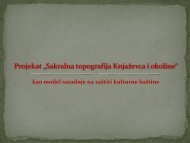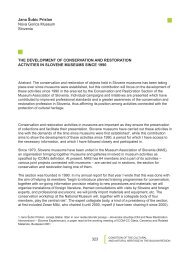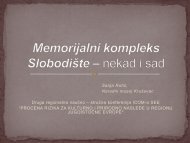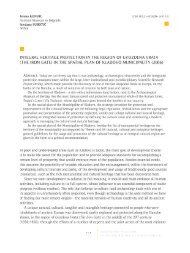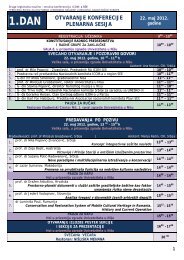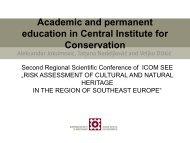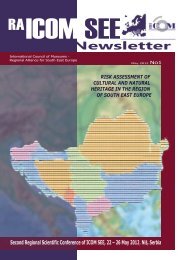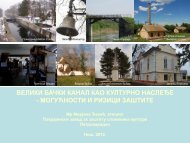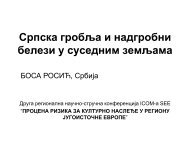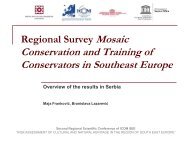67 Anica Gorgievska Institute and Museum – Bitola ... - ICOM-SEE
67 Anica Gorgievska Institute and Museum – Bitola ... - ICOM-SEE
67 Anica Gorgievska Institute and Museum – Bitola ... - ICOM-SEE
Create successful ePaper yourself
Turn your PDF publications into a flip-book with our unique Google optimized e-Paper software.
<strong>Anica</strong> <strong>Gorgievska</strong><br />
<strong>Institute</strong> <strong>and</strong> <strong>Museum</strong> <strong>–</strong> <strong>Bitola</strong><br />
Republic of Macedonia<br />
THE CONSERVATION OF THE HERACLEA LYNCESTIS MOSAICS <strong>–</strong><br />
BRIDGE FOR THE HERITAGE IN THE FUTURE<br />
Abstract. The ancient city of Heraclea Lyncestis was one of the most important cities in this part of<br />
Macedonia. Today it is the most attractive archeological site for every visitor <strong>and</strong> also great<br />
challenge for many scientists.<br />
What is the most brilliant, most impressive, most mysterious <strong>and</strong> most important in Heraclea<br />
Lyncestis are the floor mosaics.<br />
These mosaics spread on around 1.300 m2. They are present in 16 rooms of three building<br />
remains, developed using various mosaic techniques <strong>and</strong> they are the most completely preserved<br />
link between the pagan <strong>and</strong> Christian antique.<br />
Since the archeological site is of universal importance <strong>and</strong> the remains of the floor mosaics are<br />
among the best examples of this type of artistic creation of early Christianity, the imperative is to<br />
stabilize <strong>and</strong> preventively protect the mosaics in order to slow down the process of their<br />
degradation as much as possible.<br />
On the basis of information collected by joint expert minds in Europe to come out with project<br />
proposal for long-term conservation <strong>and</strong>, even more importantly, find solution for their continuous<br />
presentation because only two mosaics are presentable at the moment.<br />
The Ancient City of Heraclea Lyncestis is in the immediate vicinity of the City of <strong>Bitola</strong>, from its<br />
south side.<br />
It is located in a fertile plain, to the north protected by Baba mountain <strong>and</strong> with Siva Voda river from<br />
the south. The most famous road of the classical period <strong>–</strong> Via Ignatia <strong>–</strong> used to pass through this<br />
city. This road was the link between the Adriatic <strong>and</strong> the Aegean coasts.<br />
It is presumed that this most important city of Ancient Macedonia was established by Fillip II the<br />
Macedon, in the middle of IV century BC 1 .<br />
After the end of the Roman-Macedonian wars the destiny of Macedonia is reflected in the Roman<br />
moto that used to be successfully implemented both before <strong>and</strong> after <strong>–</strong> Divide at Impera".<br />
The Romans divided Macedonia into four meridias. Heraclea is in the fourth meridian.<br />
In the Roman period of kings Heraclea was a peaceful city along the Via Ignatia route in the frames<br />
of its metamorphosis of merging the old original institutions with the western Roman rules for state<br />
organization.<br />
1<br />
Gjorgjievska A, 2007, <strong>Bitola</strong>, Travelling through time with Heraclea Lyncestis” (“Patot niz vremeto na Heraklea<br />
Linkestis”) Monography<br />
<strong>67</strong> [<br />
CONDITION OF THE CULTURAL<br />
AND NATURAL HERITAGE IN THE BALKAN REGION
As a city with multiple century tradition, it has the necessary objects that mark that feature <strong>–</strong><br />
Thermae, Portico of the Court Room that has very sophisticated look with the verses by Hesoid<br />
(performed in his book “Works <strong>and</strong> Days”, dedicated to the Zeus <strong>and</strong> Justicia) as well as the<br />
impressive theater. These are all indicators that the life had very high cultural dimension<br />
throughout the centuries (picture 1).<br />
The most famous period of Heraclea was during the establishment of Christianity as a state<br />
religion when the city becomes the headquarters of the episcopacy. This is evident from the<br />
mentioning of the bishops about their participation on the church Events.<br />
The look of the city acquires Christian features with all typical buildings. This is evident from the<br />
beautiful architectural buildings <strong>–</strong> the Small Basilisk, the Great Basilisk, the Episcopal Residence<br />
with numerous mosaics <strong>and</strong> the Central City Fountain erected on the occasion of 35 years of rule<br />
by the very energetic Emperor <strong>–</strong> Justinian.<br />
The episcopes from Heraclea in the IV-VI century AC are mentioned not only in the community but also<br />
on the Ecumenical Councils, even sometimes they are mentioned as deputies of the Episcope from<br />
Salonika. This means that Heraclea, as Episcopal Center has important role for the overall religion.<br />
The urban life in Heraclea diminishes at the end of VI century with the attacks by the Slavs <strong>and</strong> Avarians.<br />
What is the most brilliant, most impressive, most mysterious <strong>and</strong> definitely most important in<br />
Hearclea Lyncestis are the floor mosaics.<br />
There is no doubt that the Heraclea mosaics are the product of early Christian times <strong>and</strong> they are<br />
the mark of the Christian soul. Each <strong>and</strong> every period of civilization creates its unique art <strong>and</strong> the<br />
mosaics are very good proof. Thanks to these mosaics we have an insight into the life of the early<br />
Christianity where we see “holy arts”, sincere, untouched, captivating…<br />
The circle of same motives repeats on these floors so these are classified into four groups where it<br />
is possible to recognize four elements, the four areas of the Christianity universe 2 ;<br />
1. The symmetric pictures represent the Holy Heaven <strong>–</strong> the most holy area in the Christianity<br />
universe <strong>–</strong> the place of God.<br />
2. The trees with fruits, birds, flowers, tranquil animals <strong>–</strong> are all part of the pictures of heaven/ the<br />
second area of the Christianity universe.<br />
3. Animals fight <strong>–</strong> those that chase them <strong>and</strong> those being chased mark the Earth <strong>–</strong> the third area,<br />
<strong>and</strong><br />
4. The water l<strong>and</strong>scape i.e. pictures with waters full of fish <strong>and</strong> other sea, river, real <strong>and</strong> imaginary<br />
creatures is the fourth <strong>and</strong> final area of the cosmos.<br />
All mosaics in Heraclea have unique beauty but the master piece of the early Christian art is the<br />
mosaic on the floor of the Great Basilica Nartex.<br />
The creator of the Heraclea mosaic used over 100m2 to create a “rhythmical composition” with a<br />
tendency towards symphonic principal: ideal balance <strong>and</strong> beauty with great aesthetic value, strong<br />
feelings of tranquility <strong>and</strong> elegance against the expressed dynamics <strong>and</strong> quivering (picture 2).<br />
2<br />
Tomasevic <strong>–</strong> Cvetkovic “Early Christian Floor Mosiacs in the Episcopal floor in Heraclea Lyncestis, Belgrade, 2002<br />
68 [<br />
CONDITION OF THE CULTURAL<br />
AND NATURAL HERITAGE IN THE BALKAN REGION
The representation of the mosaics on the floor of the Great Basilica Nartex is true confession of the<br />
Christian religion. By using the language of symbols we recognize the ancient alphabet of the<br />
Christian religious system 3 .<br />
In its creation the Christian art will inherit the best tradition of the ancient times. It is influenced by<br />
the Hellenism <strong>and</strong> absorbs the elements of the Egyptian, Syrian, Roman <strong>and</strong> other arts, makes<br />
sacred this complex heritage <strong>and</strong> articulates it to serve the blooming of its expression, transforming<br />
it to the requirements of the Christian science. The Christianity chooses from the polytheism<br />
everything that is Christian in nature or, as it says: “all pieces of the truth that used to be spread<br />
<strong>and</strong> merges them into the expression”.<br />
With this arts the Christians tried to depict not only what is visible to the eyes but also the invisible<br />
parts i.e. the spiritual content of the depiction.<br />
The Heraclea mosaics are unique witness of its time. They are precious source to learn about the<br />
arts <strong>and</strong> the spiritual status at those times. These mosaics spread to around 1.300 m2 (picture 3).<br />
They are present in 16 rooms of three building remains, developed using various mosaic<br />
techniques <strong>and</strong> they are the most completely preserved link between the pagan <strong>and</strong> Christian<br />
antique.<br />
We have to emphasize that some of these mosaics have not seen the light of the day until the year<br />
of 2000 <strong>and</strong> some of them for some minor prevention in the 60s, 70s <strong>and</strong> 80s.<br />
Specifically <strong>–</strong> in the period 1959 <strong>–</strong> 19<strong>67</strong> some preventive protection was performed on the mosaic<br />
floors on the exonartex, the nartex, the north <strong>and</strong> south section, the baptisterium, the<br />
catechumenium <strong>and</strong> the atrium with chapel (No. 14,8,9,11,12,13,6, 7 on the plan 1) 4 .<br />
In the period 1968 <strong>–</strong> 1974 prevention was carried out on the mosaic floors: middle section, south<br />
annex <strong>and</strong> all floors of the Episcopial Residence (No. 10,5,2,3,4,7 on the Plan) on which some<br />
conservation interventions are also visible in 1980. 5<br />
The question here is why no conservation interventions took place in the period 1974-2000 <strong>and</strong><br />
why these were not announced.<br />
Beside the conservation works <strong>and</strong> prevention on some parts of the Heraclea site architecture in all<br />
the past 20-30 years the main emphasis was put on conservation, reconstruction <strong>and</strong> revitalization<br />
of the Roman times theater so there were never optimum conditions for proper prevention of the<br />
mosaics. When it comes to restoration works of the Theater, they are separate issue which<br />
deserves another elaboration. 6<br />
3<br />
Gjorgjievska, A., 2001, Sofia “The Arts of the Early Christian Mosaics in Heraclea Lyncestis” <strong>–</strong> Materials from the 8th<br />
Scientific Forum”, The Christianity idea in the history of the European culture, 65-71<br />
4<br />
The mosaics in Heraclea were discovered in the period between 1960-184 where major <strong>and</strong> minor conservation<br />
interventions were made by the Yugoslavian <strong>Institute</strong> for Protection of the Cultural Monuments <strong>–</strong> Belgrade, headed by<br />
G.Tomasevik, Cvetkovik.<br />
5<br />
The works were resumed by the State Institution for Protection of Cultural Monuments of Serbia, headed by<br />
G.Tomasevik. Cvetkovik<br />
6<br />
We deem that that the aim to bring back to life the architecture from past centuries leads towards creation of dead-born<br />
forms. Nothing can be added or taken away since they are archetype values <strong>and</strong> only conservation <strong>and</strong> prevention<br />
activities should be undertaken <strong>–</strong> not full reconstruction. They are the lighthouse that shed the truth about the artistic<br />
tradition.<br />
69 [<br />
CONDITION OF THE CULTURAL<br />
AND NATURAL HERITAGE IN THE BALKAN REGION
Lets go back to our problem <strong>–</strong> since the very beginning we were very much aware of the complex<br />
task that is ahead of us.<br />
This is how the road map for prevention of these previous floor mosaics took place:<br />
With modest amount of funds allocated by the Ministry of Culture of the Republic of Macedonia in<br />
1998 <strong>and</strong> 1999 there was sanctioning of the floor mosaics in the Nartex (picture 4) <strong>–</strong> which is the<br />
masterpiece of the early Christian arts, the baptisterium <strong>and</strong> the catechumenium of the Great<br />
Basilica (total surface or around 150 m2).<br />
In the year of 2000 there were funds received by PHARE Program for development of culture in<br />
Macedonia which finalized the works needed for the whole complex of the Great Basilica (No.<br />
9,10,11, 5,6,7 on the Plan) in the total surface of 448 m2: the northern section <strong>–</strong> 150m, the<br />
northern annex (chapel with atrium <strong>–</strong> 48m), Naos 184m, south annex <strong>–</strong> 31m, south section <strong>–</strong> 35 m.<br />
<strong>and</strong> re-conservation was performed on the mortar underlay in the Naos (Eastern half <strong>–</strong> 370 m) .<br />
In the year of 2001 the works were focused on the mosaic surface of the Episcopal Residency with<br />
total surface of around 250m2.<br />
Since the largest conservation interventions were carried out during the PHARE Project for<br />
development of culture in Macedonia in the section below we will reflect more about the realization<br />
of this Project i.e. will provide an overview on how the works on the mosaic surfaces in the Great<br />
Basilica progressed 7 .<br />
Initial organizational procedures<br />
The organizational procedures were implemented in three phases;<br />
1. Raising of the old s<strong>and</strong><br />
The thing to do first was to remove the old <strong>and</strong> obsolete s<strong>and</strong> over these mosaics. We do not need<br />
to mention the fact that this s<strong>and</strong> dates from 20, 30, 40 years ago <strong>and</strong> our greatest enemy <strong>–</strong> time <strong>–</strong><br />
did what it could do. There were plans everywhere (picture 5). There were weeds <strong>and</strong> roots <strong>and</strong><br />
even bigger roots on occasions that were necessary to be treated biologically in order to avoid<br />
accidental ripping of the mosaic stones together with the weeds i.e. roots. On the other side, the<br />
roots release acids that damage the mortar.<br />
1. Sanitation of the mosaics<br />
After the mosaic surface was uncovered the next thing to be done was to observe the damages.<br />
Unfortunately, our ascertainment was that the damages are far greater than expected.<br />
We faced double damage: ordinary damage (coming off of the mosaics from their own surface)<br />
<strong>and</strong> damages of the mosaics from the conservated surface (picture 6).<br />
The most sensitive parts were first subject to conservation interventions <strong>–</strong> the mosaic in the<br />
Northern Annex (the Chapel with Atrium of the Great Basilica). This is mosaic made with<br />
significantly small stones that are very gentle.<br />
7<br />
<strong>Anica</strong> Gjorgjievska <strong>–</strong> advisor for conservation, Head of the Project, Momchilo Petrovski <strong>–</strong> University professors -<br />
consultant, Engin Nasuh <strong>–</strong> professional collaborator, Efto Dimovski <strong>–</strong> expert for mosaics conservation, Gjorgi Dimovski <strong>–</strong><br />
assistant for conservation, Nikola Dimovski <strong>–</strong> technical documentation<br />
70 [<br />
CONDITION OF THE CULTURAL<br />
AND NATURAL HERITAGE IN THE BALKAN REGION
-Sanitation was made on the shallow sub-spaces of the mosaic.<br />
-The unusually small stones were loose, cracked, some become perishable <strong>and</strong> were free <strong>–</strong> not<br />
bind to the surface. Some stones have fallen <strong>and</strong> were missing completely (Picture 7). Those<br />
stones were fixed immediately, were injected <strong>and</strong> retouching was done on some of them.<br />
-There was also severance of the stitch between the wall <strong>and</strong> the mosaic underlay. Since the<br />
mosaic is undividable part of the architecture it was stitched again to the walls by using the old<br />
technique system (Picture 8)<br />
The conservation interventions on the Northern Section of the Great Basilica were implemented in<br />
several directions:<br />
- In the frames of the project for archeological research that was running in the same time, we<br />
discovered, on our great satisfaction, under the existing conservated mosaic, an older one<br />
(Picture 9). It was ascertained that the mosaic in the Northern Section had southern bordure<br />
that was, in some time period, torn off from the mosaic. Larger conservation interventions were<br />
done exactly here <strong>–</strong> the bordure of 70cm was marked <strong>and</strong> imitation was done of the default<br />
(original) bordure that is visible on two spots. This activity, in fact, treated the entire southern<br />
edge of the mosaic all to the northern stylobat.<br />
The cracks that were present on several places were subject to treatment.<br />
- Every ruined (perishable) mortar was corrected. This strengthened <strong>and</strong> bind the mosaic to its<br />
default <strong>and</strong> conservated underlay.<br />
The following conservation interventions were made in the South Annex:<br />
- Stitching of the mosaic to the wall <strong>and</strong> the main damage of this mosaic <strong>–</strong> somewhere to the<br />
middle the Western portion of the mosaic was overlapping the Easter part. In other words, what<br />
we did was ‘stretching” of the mosaic in order to reach its initial status. We have to point out that<br />
this type of damage is result of the extreme climate conditions in the city of <strong>Bitola</strong>.<br />
This mosaic was also subject to the necessary injections, joining of the empty spaces <strong>and</strong><br />
minimum retouching. All other interventions were also made.<br />
- In the South Section <strong>and</strong> Naos of the Great Basilica the same situation of damages was<br />
ascertained as with the above mentioned mosaic surfaces <strong>and</strong> the interventions were basically<br />
the same, with only difference that on the Naos mosaic we identified certain anomalies on the<br />
underlay (the concrete plate) which literally sinks, it is ripped <strong>and</strong> treated. What is imperative as<br />
priority one measure in the reconservation is the correction of the plate. The deformation with<br />
large inclinations <strong>and</strong> differences in the leveling of the plate were corrected.<br />
- The last phase of protection of these mosaics was re-covering with new separated s<strong>and</strong>, first<br />
with 5 cm layer, followed by plastic jute <strong>and</strong> then one more layer of 25 cm (Picture 10).<br />
This protection also plays double role <strong>–</strong> protection from extreme climate conditions in the <strong>Bitola</strong><br />
region <strong>–</strong> tropic summers <strong>and</strong> polar winters.<br />
We can say that with this conservation interventions on these mosaics we only provided first aid<br />
treatment. The question is now how to proceed The final aim of our goal is permanent<br />
presentation of these mosaics meaning that permanent conservation treatment is necessary.<br />
The presentation of the mosaics in Heraclea so far <strong>–</strong> open, reconstructed <strong>and</strong> not very much<br />
presented looks more like a book, a good book that is written, deposited <strong>and</strong> read by none.<br />
Some of these mosaics can be also seen on slides, photos, etc. but this impression short term<br />
<strong>and</strong> with insufficient depth.<br />
Maybe during this period there is overemphasizing on the specifics of the activities on these<br />
mosaics <strong>and</strong> numerous focusing on their exceptionality however, by pointing out that problems<br />
71 [<br />
CONDITION OF THE CULTURAL<br />
AND NATURAL HERITAGE IN THE BALKAN REGION
that exist beyond the usual scope we look forward to promote interest in someone in order to<br />
achieve permanent representation of these roots of Christianity thus saving them from being<br />
forgotten.<br />
If we take into account that the archeological site of Heraclea Lyncestis is of universal importance<br />
<strong>–</strong> cultural heritage of the humanity <strong>–</strong> <strong>and</strong> the remains of the floor mosaics from the early Christian<br />
period are among the best examples of this artistic creation, there is imperative need for their<br />
permanent presentation.<br />
With this presentation we aim to provoke interest in the scientific public <strong>and</strong> on the basis of the<br />
information collected by joint expert teams from Europe to give project proposal for long-term<br />
conservation of the mosaics <strong>and</strong>, finally, identify a manner in which these mosaics will be available<br />
to the public constantly because at the moment only two mosaics are presented.<br />
We sincerely hope that the European experts will be able to assist.<br />
The floor mosaics of Heraclea Lyncestis <strong>–</strong> masterpieces of the early Christian arts <strong>–</strong> are indeed<br />
valuable to have good future.<br />
72 [<br />
CONDITION OF THE CULTURAL<br />
AND NATURAL HERITAGE IN THE BALKAN REGION
<strong>Anica</strong> \or|ievska<br />
Zavod i muzej-<strong>Bitola</strong><br />
Makedonija<br />
KONZERVACIJATA NA MOZAICITE VO HERAKLEA<br />
LINKESTIS - MOST ZA NASLEDSTVOTO KON IDNINATA<br />
Abstrakt. Anti~kiot grad Heraklea Linkestis bil eden od najzna~ajnite gradovi vo vo ovoj<br />
del na Makedonija. Denes istiot pretstavuva najprimaliv arheolo{ki lokaliteti za sekoj<br />
posetitel, a golem predizvik za mnogu nau~nici.<br />
Ona {to mo`ebi e najbrilijantno, najvpe~atlivo , najmisteriozno i sekako najzna~ajno vo<br />
Heraklea Linkestis toa se podnite mozaici.<br />
Ovie mozaici zafa}aat povr{ina od okolu 1300 metri kvadratni. Rasporedeni vo 16<br />
prostorii na tri objekti, izvedeni vo najraznovidni mozai~ni tehniki, pretstavuvaat<br />
najkompletna za~uvana vrska me|u paganskata i hristijanskata antika.<br />
Imajki vo predvid deka arheolo{kiot lokalitet e so univerzalno zna~ewe , a ostatocite od<br />
podnite mozaici se me|u najdobrite primeri na ovoj vid umetni~ka kreacija od ranoto<br />
hristijanstvo, imperativno se nalaga potrebata da se izvr{i stabilizacija i nivna<br />
preventivna za{tita za da mo`e vo {to pogolema merka da se uspori procesot na nivna<br />
degradacija.<br />
Vrz osnova na sobrani informacii od zdru`eni ekspertski umovi od Evropa da se dade<br />
predlog proekt za dolgoro~na konzervacija na istite i ona {to e najsuptilno da se iznajde<br />
re{enie za nivna postojana prezentacija, zatoa {to do sega se prezentiraat samo dva mozaici.<br />
Anti~kiot grad Heraklea Linkestis se<br />
nao|a vo neposredna blizina na <strong>Bitola</strong>, od<br />
negovata ju`na strana.<br />
Smesten vo plodnata ramnina, severno<br />
za{titen od Baba planina i reki~kata Siva<br />
voda od ju`nata strana, niz nea pominuval<br />
najpoznatiot pat na klasi~nata epoha Via<br />
Egnatia, vrskata na Jadranskoto so Egejskoto<br />
krajbre`je.<br />
Nastanokot na ovoj najzna~aen grad vo<br />
anti~ka Makedonija se vrzuva za imeto na<br />
Filip II Makedonski , vo sredinata na IV vek<br />
pred Hr 1 .<br />
Po zavr{uvaweto na rimsko -makedonskite<br />
vojni sudbinata na Makedonija e odrazena vo<br />
rimskoto moto {to uspe{no be{e<br />
primenuvano pred i potoa"divide et impera".<br />
Rimjanite ja podelile Makedonija na<br />
~etiri meridi. Heraklea e vo 4 merida.<br />
Vo rimsko -carskiot period Heraklea e<br />
mirno grat~e na Via Egnatia, svrteno kon<br />
svojata metamorfoza za spojuvawe na starite<br />
izvorni institucii so zapadnite rimski<br />
pravila na organizacija na dr`avata.<br />
Kako grad so pove}evekovna gradska<br />
tradicija gi ima neophodnite gradbi {to mu<br />
1<br />
Ѓорѓиевска, A., 2007, <strong>Bitola</strong>, Patot niz vremeto na Heraklea Linkestis, -monografsko izdanie<br />
73 [<br />
CONDITION OF THE CULTURAL<br />
AND NATURAL HERITAGE IN THE BALKAN REGION
davaat takvo obele`je: Termi, Portik-sudnica,<br />
komu sofisticiran izgled mu davaat stihovite<br />
na Hesiod (izvedeni od deloto "Dela i dni", a<br />
posveteni na bogot Zevs i Prvadata) kako i<br />
markantniot teatar, se brojni pokazateli deka<br />
na ova tlo so vekovi `ivotot imal<br />
visokokulturna dimenzija (sl 1.)<br />
Najslavniot period od svoeto postoewe<br />
Heraklea go do`ivuva vo vremeto na<br />
utvrduvaweto na hristijanstvoto kako<br />
dr`avna religija, koga gradot stanuva sedi{te<br />
na episkopija. Za toa najdobro svedo~i<br />
pomenot na episkopite za nivno u~estvo na<br />
crkovnite Sobori .<br />
Gradot dobiva fizionomija na tipi~en<br />
hristijanski grad so site karakteristi~ni<br />
objekti. @ivi svedoci se ansamblot na<br />
nepovtorlivo ubavite arhitektonski gradbi;<br />
Mala bazilika, Golema bazilika, Episkopska<br />
rezidencija so brojnite mozaici i Gradska<br />
~e{ma podignata po povod 35 godini od<br />
vladeeweto na energi~niot imperator<br />
Justinijan.<br />
Episkopite od Herakleja, od IV-VI v.ek po<br />
Hr. se spomenuvaat ne samo na pomesnite, tuku<br />
i na vselenskite sobori, duri i napati kako<br />
zamenici na solunskiot episkop . Zna~i,<br />
Heraklea kako episkopsko sedi{te ima<br />
zna~ajna uloga za po{irokata regija.<br />
Urbaniot `ivot vo Heraklea zgasnuva vo<br />
krajot na VI vek so avaro slovenskite napadi.<br />
Ona {to mo`ebi e najbrilijantno,<br />
najvpe~atlivo , najmisteriozno i sekako<br />
najzna~ajno vo Heraklea Linkestis toa se<br />
podnite mozaici<br />
Nema somnenie deka heraklejskite mozaici<br />
se deca na ranohristijanskoto vreme i<br />
obele`an pe~at na hristijanskata du{a. Deka<br />
sekoja epoha na edna civilizacija kreira<br />
umetnost koja i e svojstvena i nepovtorliva<br />
svedo~i postoeweto tokmu na ovie mozaici .<br />
Blagodarenie na niv od pazuvite na `ivotot<br />
na ranoto hristijanstvo otkrivame " sveta<br />
umetnost" bo`estveno vdahnovena , iskrena,<br />
nedoprena, ma|epsni~ka...<br />
[to se odnesuva do pretstavite na ovie<br />
podovi, ist krug na motivi se povtoruva vo<br />
site niv i zatoa istite se klasificirani vo<br />
~etiri grupi vo koi se prepoznavaat ~etirite<br />
elementi, ~etirite oblasti na hristijanskiot<br />
univerzum 2 ;<br />
1.Simetri~nite sliki go simboliziraat<br />
Carstvoto nebesno, najsvetata oblast vo<br />
hristijanskiot univerzum, oblasta na samiot<br />
Bog.<br />
2.Drvjata so plodovite, pticite, cvekinata,<br />
smirenite `ivotni se del od slikite na Rajot/<br />
neboto, vtorata oblast na hristijanskiot<br />
kosmos.<br />
3. @ivotnite vo borba, onie koi {to gonat<br />
i koi {to se goneti ja ozna~uvaat Zemjata,<br />
tretata oblast i na kraj<br />
4. Vodeniot pejza`, odnosno slikite so vodi<br />
polni so ribi i drugi morski, slatkovodni,<br />
vistinski i izmisleni su{testva , e ~etvrtata<br />
i poslednata oblast na kosmosot.<br />
Site mozaici vo Herakleja se so edinstvena<br />
ubavina, no remek delo na ranohristijanskata<br />
umetnost pretstavuva mozaikot na podot vo<br />
narteksot na Golemata bazilika.<br />
Heraklejskiot mozai~ar na povr{ina od<br />
preku 100 m 2 na frapanten na~in sozdal<br />
"ritmi~ka kompozicija" so markantna<br />
tendencija za simfoniskiot princip: idealna<br />
ramnote`a, skladna ubavina so golema<br />
estetska vrednost, silni ~uvstva so krajna<br />
smirenost i elegancija, nasproti izrazenata<br />
dinami~nost i treperewe (sl.2)<br />
Pretstavata na mozaikot na podot vo<br />
narteksot na Golemata bazilika e vistinsko<br />
ispoveduvawe na hristijanskata vera. So<br />
pomo{ na simboli~kiot jazik ja prepoznavame<br />
drevnata azbuka na hristijanskiot religiozen<br />
sistem 3 .<br />
Sozdavaj}i se, hristijanskata umetnost gi<br />
nasleduva najdobrite tradicii na stariot vek.<br />
Taa se natopuva so helenizmot gi vpiva<br />
elementite na egipetskata, siriskata,<br />
rimskata i drugi umetnosti, go sakralizira<br />
seto toa slo`eno nasledstvo, go doveduva da<br />
2<br />
Томашевиќ - Цветковиќ, Г.,2002, Београд, Корпусрановизантијских подних мозаика у епископском двору у<br />
Хераклеји Линкестис<br />
3<br />
Ѓорѓиевска, A., 2001, София "Уметноста на ранохристијанските мозаици voHераклеa Линкестис", Материјали од 8<br />
летна научна средба, Християнската идея во историята на културата на Европа, 65 - 71<br />
74 [<br />
CONDITION OF THE CULTURAL<br />
AND NATURAL HERITAGE IN THE BALKAN REGION
slu`i na polnotata na nejziniot izraz i go<br />
preobrazuva spored barawata na<br />
hristijanskata nauka.Hristijanstvoto izbira<br />
od mnogubo`e~kiot svet se {to e negovo<br />
hristijansko u{te pred Hrista, ili kako {to<br />
se veli, "site del~iwa na vistinata koi tamu<br />
bile rastureni gi soedinuva i gi vnesuva vo<br />
polnotata na otkrovenieto".<br />
So pomo{ na taa umetnost hristijanite se<br />
trudele da go prenesat ne samo ona {to e<br />
vidlivo za telesnite o~i, tuku i ona {to e<br />
nevidlivo, odnosno duhovnata sodr`ina na<br />
prika`anoto.<br />
Ne e nekoe otkritie ako se ka`e deka<br />
Heraklejskite mozaici se edinstvenoto<br />
slikarsko svedo{tvo na svoeto vreme, a so toa<br />
dragocen izvor za zapoznavawe na umetnosta i<br />
sostojbata na duhot voop{to, no bez somnenie<br />
vpe~atliv e podatokot deka ovie mozaici<br />
zafa}aat povr{ina od okolu 1300 metri<br />
kvadratni. (sl.3) Rasporedeni vo 16 prostorii<br />
na tri objekti, izvedeni vo najraznovidni<br />
mozai~ni tehniki, pretstavuvaat<br />
najkompletna za~uvana vrska me|u paganskata i<br />
hristijanskata antika.<br />
Mora da napomeneme , ili potencirame<br />
deka nekoi od ovie mozaici do 2000god. i posle<br />
nivnoto otkrivawe i nezna~itelna preventiva<br />
od {eesettite- sedumdesettite i<br />
osumdesettite godini ne go imaa videno<br />
sonceto na denot.<br />
Poprecizno od 1959g do 19<strong>67</strong>g odredena<br />
preventivna za{tita be{e napravena vrz<br />
mozai~nite podovi na eksonarteksot,<br />
narteksot, severniot i ju`niot<br />
korab,krstilnica, katihumeniumot i<br />
predvorjeto so kapela ( br. 14,8,9,11,12,13,6, 7<br />
na planot 1) 4 .<br />
Vo periodot od 1968g do do 1974g preventiva<br />
e napravena vrz mozai~nite podovi : sreden<br />
korab, ju`en aneks i site podovi vo<br />
Episkopskata rezidencija ( br. 10,5,2,3,4,7 na<br />
planot) , vrz koja oddelni konzervatorski<br />
intervencii se vidlivi i vo 1980 g. 5<br />
Vedna{ se postavuva pra{aweto zo{to od<br />
1974god. do 2000 god. vrz istite ne se pravele<br />
nikakvi konzervatorski intervencii, ili<br />
zo{to istite ne se obelodenuvale.<br />
Pokraj konzervatorskite raboti i<br />
preventiva na delovi od arhitekturata na<br />
lokalitetot Herakleja, sive ovie izminati 20-<br />
30 godini akcentot se staval na konzervacija,<br />
rekonstrukcija i revitalizacija na teatarot<br />
od rimsko vreme , taka {to nikoga{ ne se<br />
sozdale optimalni uslovi za dostojna<br />
preventive na mozaicite. [to se odnesuva pak<br />
do restavratorski raboti na teatarot , tie<br />
smetam deka pretsavuvaat poseben problem koj<br />
zaslu`uva posebna razrabotka proekcija za<br />
nekoja idna tema 6 .<br />
No da se vratime na na{iot problem, za<br />
kogo u{te na startot bevme sosema svesni deka<br />
zada~ata koja ni pretstoe{e ne e ni malku<br />
lesna.<br />
Ete glavno kako se trasira{e patot za<br />
preventivna za{tita vrz ovie vredni mozi~ni<br />
podovi.<br />
Imeno, so dodelenite skromni sredstva od<br />
strana na Ministerstvoto za kultura na R.<br />
Makedonija vo 1998g. I 1999g se saniraa<br />
mozai~nite povr{ini vo narteksot (sl.4)- ona<br />
{to pretstavuva remek delo vo<br />
ranohristijanskata umetnost , krstilnicata i<br />
katihumeniumot na Golemata bazilika (vkupna<br />
povr{ina od okolu 150 metri kvadratni).<br />
Vo 2000g objektivno e da gi respektirame<br />
sredstvata dodeleni od Fare programata za<br />
razvoj na kulturata vo Makedonija so koi se<br />
zaokru`ija rabotite na celiot kompleks na<br />
Golemata bazilika ( br. 9.10.11, 5,6,7- na<br />
planot- ili vkupna povr{ina od 448 metri<br />
4<br />
Mozai~nite podni povr{ini vo Herakleja se otkrieni vo periodot pome|u 1960 do 1974 godina , koga se<br />
napraveni nekade pogolemi nekade pomali konzervatorski intervencii. Od strana na Jugoslovenskiot institute<br />
za za{titan a spomenicite na kulturata- Belgrad, pod rakovodstvo na G.Toma{eviK, Cvetkovik<br />
5<br />
So rabotite prodol`i Republi~kiot zavod za za{titan a spomenicite na kulturata na Srbija, pod rakovodstvo<br />
na G.Toma{evik. Cvetkovik<br />
6<br />
Smetam deka streme`ot za o`ivuvawe na arhitekturata od minatite vekovi vodi kon sozdavawe na mrtvorodeni<br />
oblici. Niti mo`e ne{to da se odzeme, niti pak da se dodade zatoa {to toa se arhetipski vrednosti i vrz niv<br />
treba da se deluva samo so konzervacija i preventiva, a nikako celosna rekonstrukcija. Vpro~em tie se kako<br />
svetilnici koi ja rasvetluvaat vistinata za tvore~kata tradicija<br />
75 [<br />
CONDITION OF THE CULTURAL<br />
AND NATURAL HERITAGE IN THE BALKAN REGION
kvadratni i toa: : severen korab -150m, severen<br />
aneks ( kapela so predvorje-48m), naos 184m,<br />
ju`en aneks-31m, ju`en korab-35m. i izvr{ena<br />
e rekonzervacija na malternata podloga vo<br />
naosot ( isto~na polovina-370m). .<br />
Vo 2001 godina rabotite bea naso~eni vrz<br />
mozai~nite povr{ini na Episkopskata<br />
rezidencija so vkupna povr{ina od okolu 250<br />
metri kvadratni.<br />
So ogled na toa {to najgolemite<br />
konzervatorski intervencii se napraveni za<br />
vreme traeweto na proektot na Fare<br />
programata za razvoj na kulturata vo<br />
Makedonija, vo narednite redovi }e zboruvame<br />
za izvedbata na ovoj Proekt, odnosno }e<br />
dademe slika za tekot na rabotite vrz<br />
mozai~nite povr{ini od Golemata bazilika 7 .<br />
Po~etni organizacioni postapki<br />
Organizacionite postapki bea<br />
sosredote~eni vo tri glavni fazi;<br />
1. Podigawe na starata pesok<br />
Ona {to mora{e najprvo da se napravi<br />
be{e otstranuvaweto na starata dotraena<br />
pesok od ovie mozai~ni povr{ini. Ne treba<br />
posebno da napomenuvame deka so ogled na toa<br />
{to ovaa pesok e od pred 20, 30 - 40 godini,<br />
taka da vremeto- najgolemiot neprijatel , si go<br />
napravi svoeto. Vegetacijata zagospodarila<br />
(sl.5) . Nasekade izniknale trevki i<br />
koren~iwa, a na nekoi mesta i pogolemi<br />
koreni, vrz koi mora{e da se dejstvuva po<br />
biolo{ki pat, se so edna cel da ne dojde do<br />
kornewe na kam~iwata zaedno so korovot,<br />
odnosno trevkite. Korenite od svoja strana<br />
pak ispu{taat kiselini koi deluvaat<br />
razoruva~ki vrz malterot.<br />
1. Sanirawe na mozaicite<br />
Posle otkrivaweto na mozai~nite<br />
povr{ini se pristapi kon opservacija vrz<br />
o{tetuvawata. Za `al Na{a op{ta<br />
konstatacija be{e deka o{tetuvawata se<br />
daleku pogolemi od predviduvawata.<br />
Se sudrivme so dvojni o{tetuvawa;<br />
o{tetuvawa, ili odlepuvawa na mozaicite od<br />
sopstvenata podloga i o{tetuvawa na<br />
mozaicite od konzerviranata podloga. (sl. 6 )<br />
So konzervatorskite intervencii najprvo<br />
se dejtvuva{e vrz ona {to e najsuptilnomozaikot<br />
vo severniot aneks- pokonkretno<br />
kapela so predvorje na Golemata bazilika. Se<br />
raboti za mozaik raboten so izrazito sitni<br />
kam~iwa so ne`na struktura.<br />
- Se pristapi kon sanirawe na<br />
potklobu~uvawata,- {uplivi podprostori na<br />
mozaikot.<br />
- Neobi~no sitnite kam~iwa se razni{ale,<br />
napukale, nekoi stanale tro{ni i stoea<br />
slobodno - nevrzani za podlogata, a nekoi<br />
sosema ispadnale i gi nema{e (sl.7 )Vedna{<br />
istite se fiksiraa, se inektiraa, a vrz nekoi<br />
se napravija nekoi neophodni retu{i.<br />
- Konstatiravme i odvojuvawe na spojot na<br />
zidot so mozai~nata podloga. Voedno ,<br />
mozaikot kako neraskinliv del od<br />
arhitekturata se op{i za zidovite i toa po<br />
sistem na starata tehnika (sl. 8)<br />
Konzervatorskite intervencii na<br />
severniot korab na Golemata bazilika se<br />
odvivaa vo nekolku nasoki;<br />
- Vo ramkite na proektot za arheolo{ki<br />
istra`uvawa koj te~e{e vo isto vreme, pokraj<br />
drugoto na na{e golemo zadovolstvo pod<br />
postoe~kiot konzerviran mozaik vo severniot<br />
aneks otkrivme drug postar (sl.9)<br />
Konstatirano e deka mozaikot vo severniot<br />
korab pak imal ju`na bordura, koja vo nekoe<br />
vreme e otkinata od nego. Pogolemi<br />
konzervatorski intervencii se napraveni<br />
tokmu tuka- se napravi obele`uvawe na<br />
bordurata od 70 sm I se imitira po primerot<br />
na starata koja e vidliva na dve mesta. So ovaa<br />
aktivnost vsu{nost se istretira celata ju`na<br />
ivica na mozaikot, se do severniot stilobat.<br />
Se dejstvuva{e vrz puknatinite koi gi<br />
ima{e na pove}e mesta.<br />
- Sekoj propadnat ( razoren) tro{en malter<br />
se koregira, so {to se zacvrsti samiot mozaik<br />
za sopstvenata i konzerviranata podloga.<br />
7<br />
<strong>Anica</strong> \or|ievska - sovetnik konzervator - rakovoditel na proektot, Mom~ilo Petrovski - univerzitetski<br />
profesor - stru~en konsultant, Engin Nasuh - stru~en sorabotnik, Efto Dimovski - konzervator mozai~ar, Gorgi<br />
Dimovski - pomo{nik konzervator, Nikola Dimovski - tehni~ki dokumentator<br />
76 [<br />
CONDITION OF THE CULTURAL<br />
AND NATURAL HERITAGE IN THE BALKAN REGION
- Vo ju`niot aneks se napravija slednite<br />
konzervatorski intervencii; op{ivawe na<br />
mozaikot za zidot i ona {to be{e glavno<br />
o{tetuvawe na ovoj mozaik; nekade kon<br />
sredinata be{e nalegnata zapadnata polovina<br />
na mozaikot vrz isto~nata. Slobodno ka`ano<br />
se prave{e eden vid rastegnuvawe na<br />
mozaikot, so cel da se dojde do prvobitnata<br />
sostojba. Mora da naopomeneme deka ovoj tip<br />
na o{tetuvawe e rezultat na ekstremnite<br />
klimatski uslovi vo <strong>Bitola</strong>.<br />
I vrz ovoj mozaik se napravija potrbnite<br />
inektirawa, fugirawa i minimalni retu{i.<br />
Site potklobu~eni mesta se istretiraa.<br />
- Vo ju`niot korab i naosot na Golemata<br />
bazilika konstatirana e istata sostojba na<br />
o{tetuvawa kako i na site pogore navedeni<br />
mozai~ni povr{ini i se intervenira{e<br />
glavno po istiot redosled, so taa razlika {to<br />
na mozaikot od naosot zabele`avme izvesni<br />
anomalii na podlogata ( betonskata plo~a),<br />
koja vo vistinska smisla na zborot toni, se<br />
potklobu~uva i korni. Ona {to be{e<br />
imperativno , kako prvostepena merka e<br />
rekonzervacijata - korekcija na plo~ata. Se<br />
koregira deformacijata so golemite padovi i<br />
razliki vo nivelacijata.<br />
- Poslednata faza za za{tita na ovie<br />
mozaici zna~e{e prepokrivaweto so nova<br />
separirana pesok i toa najprvo vo sloj od 5 sm.,<br />
pa plasti~na juta, pa u{te eden sloj od 25 sm<br />
(sl.10)<br />
Ovaa za{tita ja odigruva i svojata dvojna<br />
uloga- za{tita od ekstremnite klimatski<br />
uslovi vo bitolskiot kraj;tropski leta,<br />
polarni zimi.<br />
Mo`e slobodno da ka`eme deka nie so<br />
konzervatorskite intervencii vrz ovie<br />
mozaici samo mu dadovme tretman od prva<br />
pomo{ na istite. No vedna{ se postavuva<br />
pra{aweto {to ponatamu Krajna cel na<br />
na{ata rabota e postojana prezentacija na<br />
ovie mozai~ni povr{ini, so {to bi imale<br />
permanenten konzervatorski tretman vrz<br />
istite..<br />
Dosega{nnata na<br />
heraklejskite mozaici, otvoreni, sanirani i<br />
ne prezentirani pove}e nalikuvaat na kniga,<br />
dobra kniga, napi{ana, deponirana i nikoga{<br />
od nikogo ne pro~itana. Navistina del od ovie<br />
mozaici mo`at da se vidat na slajdovi,<br />
fotografii i sli~no, me|utoa taa impresija e<br />
kratkotrajna i povr{na. Smetame deka onoj<br />
moment koga okoto dobiva drazba od<br />
avtenti~niot ambient,pobuduva posilni<br />
impresii.<br />
Mo`ebi celo ova vreme se ~uvstvuva<br />
na{eto prekumerno potencirawe okolu<br />
specifi~nosta na rabotite vrz ovie mozai~ni<br />
povr{ini i brojni epiteti za nivnata<br />
isklu~itelnost. No, uka`uvaj}i na<br />
postoeweto na problemite {to se nao|aat<br />
nadvor od krugot na lesno procenuvawe<br />
iskreno se nadevame deka kaj Nekogo }e<br />
zapalime iskra na razbirawe za da ne dovede<br />
do patot za postojana prezentacija na ovie<br />
slikoviti koreni na hristijanstvoto, so {to<br />
}e bidat spaseni od kanxite na zaboravot<br />
Ako se ima vo predvid deka arheolo{kiot<br />
lokalitet Heraklea Linkestis e lokalitet so<br />
univerzalno zna~ewe , ili so eden zbor<br />
kulturno nasledstvo na ~ove{tvoto, a<br />
ostatocite od podnite mozaici od<br />
ranohristijanskiot period se me|u najdobrite<br />
primeri na ovoj vid umetni~ka kreacija,<br />
imperativno se nalaga potrebata za nivna<br />
postojana prezentacija .<br />
Preku ova izlagawe na{a cel e da<br />
predizvikame interes kaj nau~nata javnost i<br />
vrz osnova na sobrani informacii od<br />
zdru`eni ekspertski umovi od Evropa da se<br />
dade predlog proekt za dolgoro~na<br />
konzervacija na istite i ona {to e<br />
najsuptilno da se iznajde re{enie za nivna<br />
postojana prezentacija, zatoa {to do sega se<br />
prezentiraat samo dva mozaici.<br />
Iskreno se nadevame deka ekspertite od<br />
Evropa vo mnogu ke pomognat zatoa {to ona<br />
{to }e se odlu~i denes ke bide presuda za<br />
nivnata idnina.<br />
Podnite mozaicite vo Heraklea Linkestis,<br />
remek dela na ranohristijanskata umetnost<br />
imaat vrednost dostojna za taa idnina.<br />
77 [<br />
CONDITION OF THE CULTURAL<br />
AND NATURAL HERITAGE IN THE BALKAN REGION
1<br />
3<br />
2<br />
4<br />
Figure 1 Heraklea Linkestis <strong>–</strong> panorama<br />
Figure 2 Great Basilica, Nartex, mosaic, detail<br />
Figure 3 Plan of the buildings with mosaic<br />
floors<br />
Figure 4 Mosaic in the nartex before the<br />
conservation<br />
Slika 1 Heraklea Linkestis- panorama<br />
Slika 2 Golema bazilika, narteks, mozaik,<br />
detal<br />
Slika 3 Plan na objektite so mozai~ni<br />
podovi<br />
Slika 4 Mozaik vo narteksot, pred<br />
konzervacija<br />
78 [<br />
CONDITION OF THE CULTURAL<br />
AND NATURAL HERITAGE IN THE BALKAN REGION
5 5<br />
Figure 5 Vegetation on the mosaic floors<br />
Figure 6 Detachment of the mosaic from its<br />
original underlying support<br />
Figure 7 Loose <strong>and</strong> dilapidated stones<br />
6<br />
Slika 5 Vegetacija vrz mozai~nite podovi<br />
Slika 6 Odlepuvawe na mozaikot od<br />
sopstvenata podloga<br />
Slika 7 Razni{ani i raspadnati kam~iwa<br />
79 [<br />
CONDITION OF THE CULTURAL<br />
AND NATURAL HERITAGE IN THE BALKAN REGION
Figure 8 Detachment of the wall from the<br />
mosaic floor<br />
Figure 9 Unearthing of an older mosaic under<br />
the existing one<br />
Figure 10 Covering of the mosaics with new<br />
separated s<strong>and</strong><br />
8<br />
Slika 8 Odlepuvawe na zidot od<br />
mozai~niot pod<br />
Slika 9 Otkrivawe na postar mozaik pod<br />
postoe~kiot<br />
Slika 10 Pokrivawe na mozaicite so nova<br />
separirana pesok<br />
9<br />
10<br />
80 [<br />
CONDITION OF THE CULTURAL<br />
AND NATURAL HERITAGE IN THE BALKAN REGION



